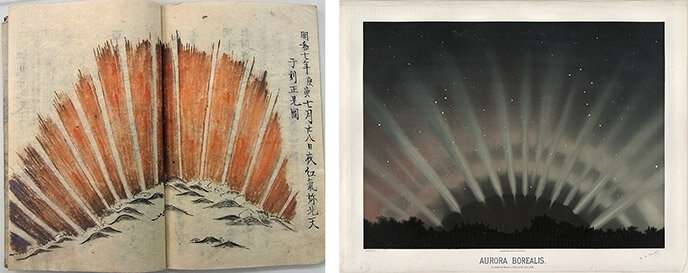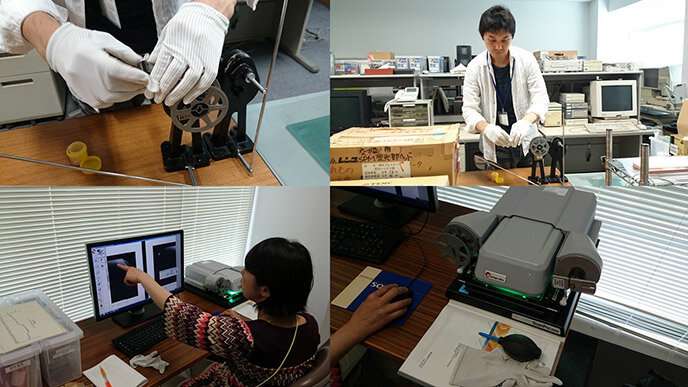Centuries-old drawings lead to better understanding of fan-shaped auroras

Physics researchers and literature researchers have joined together to better understand the rare natural phenomenon of white and red auroras fanning across the night sky in Japan. Armed with drawings and descriptions dating back to the 1700s, microfilm from the 1950s, and today's spectral image data, they've confirmed the accuracy of the older depictions. They've also started to understand how the fan-shaped auroras appear, both in the sky and to the eye.
The team published their results on May 17, 2019, in Journal of Space Weather and Space Climate.
Red auroras are fan-shaped auroras characterized by light that appears to begin at the horizon, stretching into white fingers that spread wide across the sky. The fan is infused with a red glow.
"These phenomena are rare, but potentially disrupt man-made ground-based systems, including power grids," said paper author Ryuho Kataoka, an associate professor at National Institute of Polar Research and the Graduate University for Advanced Studies (SOKENDAI) in Tokyo, Japan. "If we understand such auroras, it may help mitigate the possible natural hazard they could produce."
The first depiction of such an aurora appears in a drawing from 1770. On September 17 of that year, the greatest magnetic storm to ever occur over Kyoto, Japan was recorded. During a magnetic storm, more charged particles are violently blown into the Earth's outer atmosphere. As they crash into one another, the energized atmospheric particles lose energy because of emitting light.
"In the modern-day era, one of the strongest solar activities occurred in 1957," Kataoka said. "Auroras appeared over Japan several times in a few years around that event."
On February 11, 1958, several Japanese meteorologists observed red auroras in northern Japan. Some took the first photographs of the fan-shaped auroras while others drew them. Through modern analysis, Kataoka and the team found that the photographs caught more data than might be available to the human eye, such as thin, green pillars dispersed through the aurora.
"It's still challenging to understand the dynamic coupling between the space and atmosphere during the largest magnetic storms," Kataoka said.

The colors of auroras contain trace evidence of which particles crashed where. The bulk motion of the auroras tells us the active coupling between the space and atmosphere in the middle latitude when plasma gets into the atmosphere at a large scale. With this information, researchers may be able to determine the exact nature of the largest magnetic storms.
Next, the researchers plan to simulate the effects of space weather in the outer atmospheres during the special occasion of fan-shaped auroras and to reveal how they were created.
More information: Ryuho Kataoka et al, Fan-shaped aurora as seen from Japan during a great magnetic storm on February 11, 1958, Journal of Space Weather and Space Climate (2019). DOI: 10.1051/swsc/2019013
Provided by Research Organization of Information and Systems





















